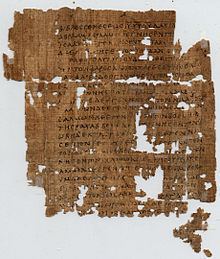Name P. Oxy. 2 Date ~250 | Originally published 1898 | |
 | ||
Size 1 leaf; 12 × 25 cm; 37–38 lines/page Similar Papyrus 4, Papyrus 3, Papyrus 9, Papyrus 75, Papyrus 46 | ||
Papyrus 1 (in the Gregory-Aland numbering) designated by
Contents
Description
The manuscript is a fragment of one leaf, one column per page, 27-29 lines per page, roughly 14.7 cm (6 in) by 15 cm (6 in). The original codex was arranged in two leaves in quire.
The surviving text of Matthew are verses 1:1-9, 12 and 13.14-20. The words are written continuously without separation. Accents and breathings are absent, except one rough breathing in line 14 of the recto. The nomina sacra are written in abbreviated forms: ΙC XC YC ΠNA KΣ.
Text
The Greek text-type of this codex is a representative of the Alexandrian. Aland placed it in Category I.
According to scholars,
Verso
[1:1] βιβλος γενεσεως ΙΥ ΧΥ ΥΥ δαυιδ [ΥΥ]αβρααμ [1:2] αβρααμ ε̣γ̣εννησεν τον̣ [ισαακ]ισαακ δ̣[ε] ε̣γενν̣η̣σεν τ[ον] ιακω̣β̣ [ιακωβ]δε εγ[ε]ν̣ν̣ησεν̣ τ̣ον̣ ιου̣δαν κ̣[α]ι̣ τ̣[ους]α̣[δ]ελφο̣υ̣ς αυτου [1:3] ιουδα̣ς̣ δ̣ε εγεν̣ν̣η̣σ̣ε̣ν̣ τον φαρες και τον ζαρε εκ της θα̣μ̣αρ̣ φαρες δε εγεννησεν τον ε̣σρ̣ωμεσ[ρω]μ̣ δε εγ̣ε̣ννη̣σ̣ε̣ν τ̣[ο]ν̣ α̣ρ̣α̣μ̣ [1:4] α̣[ραμ]δε̣ [ε]γ̣ε̣ννησεν το̣ν̣ α̣μ̣μ̣ι̣ν̣α̣δ̣α̣β̣ α̣μ̣μ̣[ι]ν̣α̣δ̣[α]β δε εγεννησεν̣ τον ναασ̣σωνν̣αα[σ]σων δε εγενν[ησ]ε̣ν τον σαλ̣[μω]ν[1:5] σαλμων δε εγενν[η]σ̣εν τον βοες̣ [εκ]της ραχαβ βοες δε ε̣γ̣ε̣ννησεν τον ιωβηδ εκ της ρ[ο]υθ ιω̣[βηδ δ]ε εγεννη̣σεν τον ιεσ̣σ̣α̣ι [1:6] ιεσ̣σ̣[αι] δ̣ε ε̣γ̣ε̣ν̣νησεντον δα̣υ̣ι̣δ̣ τ̣ον βα̣σιλ̣ε̣[α δαυ]ι̣δ̣ δ̣ε̣ εγ̣εννησ̣εν τον σο̣λο̣μωνα̣ ε̣κ̣ τ̣η̣ς ουρειου. [1:7] σο̣λομ̣ων δε εγενν̣ησ̣εν̣ τ̣ο̣ν̣ [ρ]οβοαμ ροβοα̣μ δε εγ̣ενν̣η̣σ̣εν̣ τ̣[ο]ν̣ [αβει]α αβ̣ει̣α̣ δεεγεν̣ν̣ησεν [το]ν ασα̣[φ] [1:8] [α]σ[α]φ̣ δε̣ ε̣γ̣ε̣ννη̣σ̣ε̣ν̣ τον ιωσαφατ̣ ι̣[ω]σ̣α̣φατ δ[ε] ε̣γε̣νν[η]σ̣ε̣[ν] το̣ν̣ ιωραμ ιωρ̣α̣μ̣ δε εγεν̣[νησεντον] ο̣ζε̣[ι]α̣ν [1:9] οζει̣ας̣ δ̣ε εγ̣εν̣[νησεν]lacuna [1:12] lacuna [μετοικεσιαν βαβυλωνος ιεχονι]ας εγ[εννησεν] lacunaRecto
[τον σ]α̣δω[κ σ]αδωκ̣ δε̣ ε̣γεννησεν το[ναχειμ] αχ̣ειμ δε εγε[ν]νησεν τον ελιου[δ][1:15] [ελιου]δ̣ δ̣ε̣ εγ[εν]νη̣[σ]ε̣[ν] τον ελε̣α̣ζαρ ελε[αζ]α̣ρ [δε εγ]ενν̣ησεν [το]ν μ̣α̣θ̣θα̣ν̣ μαθθα̣[ν]δ̣ε ε̣γε̣ν̣νη̣[σ]ε̣ν τον̣ [ι]ακωβ [1:16] ια̣κωβ δε[εγ]εννησ̣εν̣ τ̣ον ιωσ̣η̣φ τον α̣νδρα μ̣[α]ρ̣ι̣ας̣ [ε]ξ ης εγενν[ηθ]η̣ ΙΣ ο λεγομενο[ς ΧΣ][1:17] π̣ασ̣α̣ι̣ ο̣υ̣ν̣ γ̣ε̣[νε]α̣ι̣ α̣πο αβρααμ εω̣ς̣δαυιδ γενεαι ΙΔ και̣ απο̣ [δ]α̣[υ]ι̣δ̣ [ε]ω̣ς̣ τ̣η̣[ς]μετοικεσ̣ια̣ς βαβυλωνο̣[ς] γ̣ε[νεαι] ΙΔ κ̣α̣[ι]α̣π̣ο της μετ̣[οι]κεσι̣ας βα̣β[υ]λων̣[ο]ς εωςτου ΧΥ γ̣ενε̣α̣ι̣ [Ι]Δ [1:18] του δε ΙΥ ΧΥ η γενεσις ουτως ην μ̣ν̣ηστ̣ε̣[υ]θεισης της μητρος αυτου μ̣[αρι]α̣[ς] τω̣ [ιω]σηφ πριν η συν[ε]λ̣θε̣[ι]ν αυ[το]υ̣[ς] ε̣υ̣ρε̣[θη] ε̣ν γ̣αστρι εχουσα̣ ε̣[κ ΠΝΣ αγιου] [1:19] [ιωσηφ δε ο] ανη̣ρ̣ α̣υ̣τ̣η̣ς̣ [δι]κ̣α̣ι[ος ων και μη θελων αυτην]δ̣ειγμα̣[τ]ε̣[ισαι εβουλη]θ̣η̣ [λαθραα]π̣ο̣λυ[σαι] α̣[υ]τ̣[η]ν̣ [1:20] [τ]αυ̣τ̣α̣ [δε αυτου ενθ]υ̣μ̣η[θεντος ι]δ̣ο̣υ̣ α̣γ̣[γελο]ς̣ ΚΥ [κ]α̣[το]ν̣αρ [εφανη αυ]τω̣ [λεγων] ι̣ω̣σ̣[η]φυιος] δ̣[αυιδ] μ̣[η] φο̣[βηθη]ς̣ π̣α̣ρ̣[αλαβ]ει̅[μ]α̣ρι̣α̣ν̣ [την] γ̣υ̣ναι[κα σου] τ̣ο̣ [γαρ εν αυτη γεν]νηθ̣ε̣ν̣ ε̣[κ] ΠΝΣ [εστιν] α̣[γιου][1:21-23] lacunaμε̣[θερμηνευομενον μεθ ημων ο ΘΣ]History
Bernard Pyne Grenfell and Arthur Surridge Hunt discovered this papyrus at Oxyrhynchus in Egypt, on the third or fourth day of day of excavation, January 13 or 14, 1897. Their findings were published in the first volume of The Oxyrhynchus Papyri in 1898. The manuscript was examined by Francis Crawford Burkitt, Herman C. Hoskier, Comfort and many other scholars.
Grenfell and Hunt collated its text against the Textus Receptus and against the text of Westcott-Hort. They found that the manuscript belongs to the same class as the Sinaiticus and Vaticanus codices, and has no Western or Byzantine proclivities. Usually it agrees with these two codices, where they are in agreement. Where they differ, the manuscript is near to Vaticanus, except in one important case (του δε Ιησου Χριστου), where it agrees with Sinaiticus.
It was the earliest known manuscript of the New Testament until the discovery of
